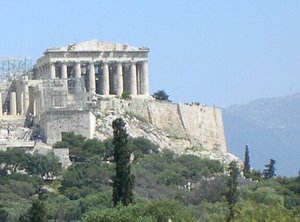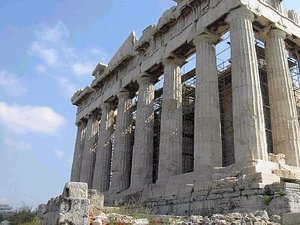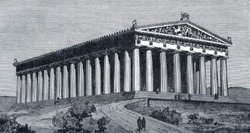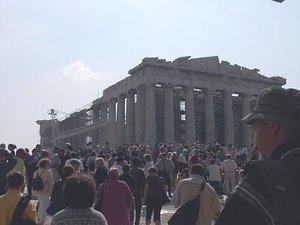Parthenon
|
|
The Parthenon (Greek: Παρθενών) is the most famous surviving building of Ancient Greece and one of the most famous buildings in the world. The building has stood atop the Acropolis of Athens for nearly 2,500 years and was built to give thanks to Athena, the city's patron goddess, for the salvation of Athens and Greece in the Persian Wars. The building was officially called the Temple of Athena the Virgin, and its popular name derives from the Greek word παρθένος (parthenos), a virgin.
The Parthenon replaced an older temple which had been destroyed by the Persians. As well as being a temple, the Parthenon was used as a treasury, and was the location of the treasury of the Delian League, which later became the Athenian Empire.
| Contents |
Design and construction
The Parthenon was built at the initiative of Pericles, the leading Athenian politician of the 5th century BC. It was built under the general supervision of the sculptor Phidias, who also had charge of the sculptural decoration. The architects were Iktinos and Kallikrates. Construction began in 447 BC and the building was substantially completed by 438 BC, but work on the decorations continued until at least 433 BC. Some of the financial accounts for the Parthenon survive, and show that the largest single expense was transporting the stone from Mount Pentelicus, about 16km from Athens, to the Acropolis. The funds were partly drawn from the treasury of the Delian League, which was moved from the Panhellenic sanctuary at Delos to the Acropolis In 454 BC.
Although the nearby Temple of Hephaestus is the most complete surviving example of a Doric order temple, the Parthenon, in its day, was regarded as the finest. The temple, wrote John Julius Norwich, "enjoys the reputation of being the most perfect Doric temple ever built. Even in antiquity, its architectural refinements were legendary, especially the subtle correspondence between the curvature of the stylobate, the taper of the naos walls and the entasis of the columns." The stylobate is the platform on which the columns stand. It curves upwards slightly for optical reasons. Entasis refers to the slight swelling of the columns as they rise, to counter the optical effect of looking up the temple. The effect of these subtle curves is to make the temple look even more symmetrical than it actually is.
Measured at the top step, the dimensions of the base of the Parthenon are 30.9 metres by 69.5 metres. The cella was 29.8 metres long by 19.2 metres wide, with internal Doric colonnades in two tiers, structurally necessary to support the roof. On the exterior, the Doric columns measure 1.9 metres in diameter and are 10.4 metres high. The corner columns are slightly larger in diameter. The stylobate has an upward curvature towards its centre of 60 millimetres on the east and west ends, and of 110 millimetres on the sides.
Decorations
The Parthenon was elaborately decorated with marble sculptures both internally and externally. These survive only in part, but there are good descriptions of most of those parts that have been lost. On the eastern pediment (the triangular area above the columns on the "front" and "back" of the temple) was a depiction of the birth of Athena. The western pediment showed Athena's battle with Poseidon for possession of the land of Attica. Metopes ran along the outer frieze of all four sides of the temple, above the lines of columns and below the pediments. These showed, on the southern side the battle of the Lapiths and the Centaurs, on the east the battle of the gods and the giants, and on the west the battle of the Greeks and the Amazons. It is not known what was depicted on the northern side: it may have been scenes from the Trojan War.
Internally, the cella was lined on three sides with a frieze showing the great procession of the Panathenaia, the main annual festival honouring Athena. On the fourth, eastern, side was a frieze showing all the gods of the Greek pantheon.
Although the pure white marble of surviving Ancient Greek temples appeals to the modern aesthetic, the Parthenon, like all ancient buildings, was at least partly painted, though scholars dispute the extent and the colour scheme. It is known that the internal ceilings were painted a deep blue, and that the statuary groups on the pediments were painted in bright colours. Some scholars believe that the upper parts of the Parthenon were painted bright red and blue, so that the sculptures would stand out in greater relief when seen from below.
Later history
The Parthenon survived as the most important temple of the Ancient Greek religion for close to a thousand years. It was certainly still intact in the 4th century AD, by which time it was already as old as Notre Dame Cathedral in Paris is now, and far older than St. Peters in Rome. But by that time Athens was no more than a provincial city of the Roman Empire, albeit one with a glorious past. Sometime in the 5th century the great statue of Athena was looted by one of the Emperors, and taken to Constantinople, where it was later destroyed, possibly during the sack of the city during the Fourth Crusade in 1204.
Shortly after this the Parthenon was converted to a Christian church. In Byzantine times it was the Church of the Theotokos ( Virgin Mary), and at the time of the Latin Empire it became a Catholic Church of Our Lady. The conversion of the temple to a church involved removing the internal columns and some of the walls of the cella, and the creation of an apse at the eastern end. This inevitably led to the removal and dispersal of some of the sculptures. Those that depicted pagan gods were probably removed deliberately, and may have been destroyed.
In 1456 Athens fell to the Ottomans, and the Parthenon was converted again, into a mosque. Contrary to subsequent mythology, the Ottomans were generally respectful of ancient monuments in their territories, and did not wilfully destroy the antiquities of Athens, though they had no actual program to protect them. In times of war they were willing to demolish them to provide materials for walls and fortifications. A minaret was added to the Parthenon, but otherwise it was not damaged further. European visitors in the 17th century testified that the building was largely intact.In 1687 the Parthenon suffered its greatest blow when the Venetians attacked Athens, and the Ottomans fortified the Acropolis and used the Parthenon as a powder magazine. On September 26 a Venetian shell exploded the magazine and the building was partly destroyed. The internal structures were demolished, whatever was left of the roof collapsed, and some of the pillars, particularly on the southern side, were decapitated. The sculptures suffered heavily. Many fell to the ground and their pieces were later made souvenirs. After this the building fell into disuse.
Recent events
By the late eighteenth century many more Europeans were visiting Athens, and the picturesque ruins of the Parthenon were much drawn and painted, helping to arouse sympathy in Britain and France for Greek independence. In 1801 the British ambassador at Constantinople, the Earl of Elgin, obtained a firman (permit) from the Sultan to make casts and drawings of the antiquities on the Acropolis, to demolish recent buildings if this was necessary to view the antiquities, and to remove sculptures from them. He took this as permission to collect all the sculptures he could find. Some he prised from the building itself, others he collected from the ground, still others he bought from local people.
Today these sculptures are in the British Museum, where they are known as the Elgin Marbles. Other sculptures from the Parthenon are in the Louvre in Paris and in Copenhagen. Most of the remainder are in the Acropolis Museum which stands a few metres to the south-east of the Parthenon. A few can still be seen on the building itself. The Greek government has been campaigning for many years for the British Museum sculptures (which it calls the Parthenon Marbles) to be returned to Greece. The British Museum has steadfastly refused to consider this, and successive British governments have been unwilling to force the Museum to do so (which would require legislation).
When independent Greece gained control of Athens in 1832, the minaret was removed from the Parthenon and all the medieval and modern buildings on the Acropolis removed. The area became a historical precinct controlled by the Greek government. Today it attracts millions of tourists every year, who troop up the path at the western end of the Acropolis, through the restored Propylaea, and up the Panathenaic Way to the Parthenon, which is surrounded by a low fence to prevent damage.
Today the greatest threats to the Parthenon are environmental. Athens has grown enormously since World War II and has major problems with traffic congestion and air pollution. Vibration from Athens traffic threatens the Parthenon's foundations, and corrosion of its marble by acid rain polluted by car exhausts threatens the remaining sculptures and the temple itself. Over the past 20 years the Greek government and the city of Athens have made some progress on these issues, but the future of the Parthenon is still a matter of some concern.
Parthenonnashville1.jpg
Treasury or temple?
Architecturally the Parthenon is clearly a temple, formerly containing the famous cult image of Athena by Phidias and the treasury of votive offerings. Since actual Greek scrifices always took place at an altar invariably under an open sky, the Parthenon does not suit some definitions of "temple". Thus some scholars have argued that the Parthenon was only used as a treasury. While this opinion was first formed late in the 19th century, it has gained strength in recent years. The majority scholarly opinion still sees the building in the terms Walter Burkert described for the Greek sanctuary, consisting of temenos, altar and temple with cult image (Burkert 1985 pp 84 – 92). See Holtzmann 2003 for a complete review of the debate.
See also
Sources and further reading
- Beard, Mary. The Parthenon. Harvard University: 2003. ISBN 067401085X.
- Burkert, Walter. Greek Religion. Harvard University: 1985 ISBN 0-674-36281-0 (paperback)
- Cosmopoulos, Michael (editor). The Parthenon and its Sculptures. Cambridge University: 2004. ISBN 0521836735.
- Holtzmann, Bernard, L'Acropole d'Ath讥s : Monuments, cultes et histoire du sanctuaire d'Ath计 Polias, Paris, 2003. ISBN 2708406876.
- Tournikio, Panayotis. Parthenon. Abrams: 1996. ISBN 0810963140.
- Woodford, Susan. The Parthenon. Cambridge University: 1981. ISBN 0521226295.
External links
- The Parthenon Marbles (http://www.mistral.co.uk/hammerwood/elgin.htm)
- Hellenic Ministry of Culture — The Acropolis of Athens: The Parthenon (http://www.culture.gr/2/21/211/21101a/e211aa01.html) (official site with a schedule of its opening hours, tickets and contact information)
- The Acropolis of Athens (http://www.culture.gr/2/21/211/21101a/e211aa01.html). (Greek Culture Ministry website)
- Metropolitan Government of Nashville and Davidson County — The Parthenon (http://www.nashville.gov/parthenon/index.htm)





